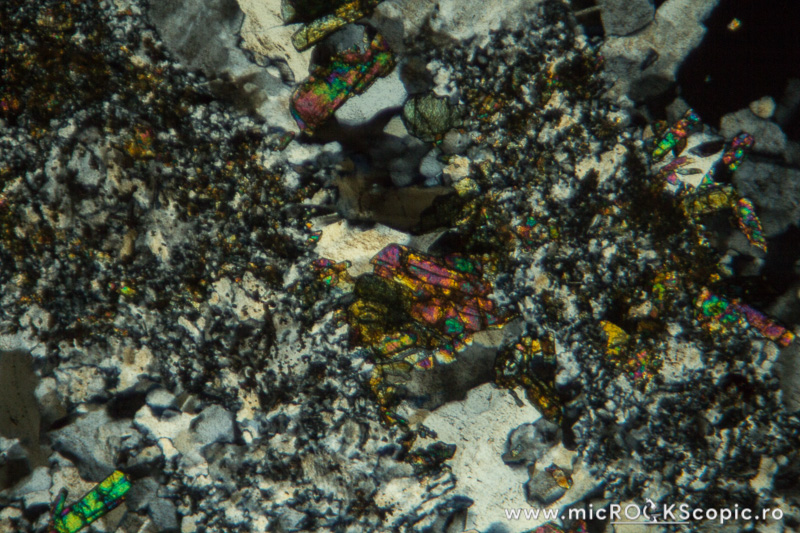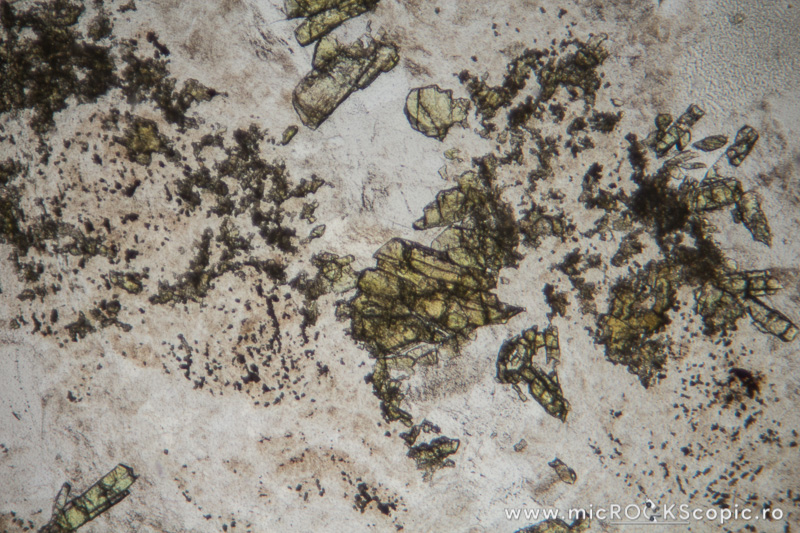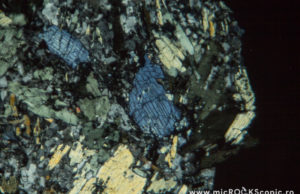About Clinozoisite-Epidote
From Greek for increase, because the base of the prism has one side longer than the other.
Clinozoisite-Epidote hand-specimen
Formula: [Ca2][Al3]O(Si2O7)(SiO4)(OH) – [Ca2][Al2Fe3+]O(Si2O7)(SiO4)(OH)
System: Monoclinic
Color: Yellowish-green, green, brownish-green, black
Lustre: Vitreous, Pearly
Hardness: 6
Density: 3.38–3.49
System: Monoclinic
Color: Yellowish-green, green, brownish-green, black
Lustre: Vitreous, Pearly
Hardness: 6
Density: 3.38–3.49
Clinozoisite-Epidote PPL properties
Relief: High positive (both clinozoisite and epidote)
Habit/Form: Often found as anhedral grains or granular aggregates. Crystals are columnar, prismatic, bladed, or acicular with the long dimension parallel to the b axis. Columnar or radial aggregates are relatively common. Sections through crystals are usually six-sided or rectangular. Detrital grains are usually rounded or platy parallel to the basal cleavage. Oriented intergrowths with zoisite may be found, as can grains with brown allanite cores and epidote rims.
Color: Clinozoisite is colorless; epidote is colorless, pale yellow, pale green, greenish yellow, yellowish green
Pleochroism: Colourless to yellow and green.
Cleavage: Perfect basal cleavage {001}.
Habit/Form: Often found as anhedral grains or granular aggregates. Crystals are columnar, prismatic, bladed, or acicular with the long dimension parallel to the b axis. Columnar or radial aggregates are relatively common. Sections through crystals are usually six-sided or rectangular. Detrital grains are usually rounded or platy parallel to the basal cleavage. Oriented intergrowths with zoisite may be found, as can grains with brown allanite cores and epidote rims.
Color: Clinozoisite is colorless; epidote is colorless, pale yellow, pale green, greenish yellow, yellowish green
Pleochroism: Colourless to yellow and green.
Cleavage: Perfect basal cleavage {001}.
Clinozoisite-Epidote XPL properties
Isotropy/Anisotropy: Anisotropic
Interference color: Clinozoisite – order I gray, white and yellow; often anomalous blue or yellow-brown.
Epidote – order II – III (very bright or ‘fluorescent’); increasing with increase in iron content. The maximum interference colors range from low second-order to upper third-order colors.
Extinction angle: Parallel / 0° / straight to length of elongate crystals and inclined excinction relative to its {001} cleavage (0-25° for the clinozoisite and 25-40° for the epidote).
Twins: Multiple normal twinning on {100} is moderately common.
Uniaxial/Biaxial: Biaxial, Clinozoisite (+) and Epidote (-)
Optic axial angle (2V): Clinozoisite 2V measured: 14 – 90°, calculated: 72 – 86°
Epidote 2V measured: 90 – 116°, calculated: 62 – 84°
Interference color: Clinozoisite – order I gray, white and yellow; often anomalous blue or yellow-brown.
Epidote – order II – III (very bright or ‘fluorescent’); increasing with increase in iron content. The maximum interference colors range from low second-order to upper third-order colors.
Extinction angle: Parallel / 0° / straight to length of elongate crystals and inclined excinction relative to its {001} cleavage (0-25° for the clinozoisite and 25-40° for the epidote).
Twins: Multiple normal twinning on {100} is moderately common.
Uniaxial/Biaxial: Biaxial, Clinozoisite (+) and Epidote (-)
Optic axial angle (2V): Clinozoisite 2V measured: 14 – 90°, calculated: 72 – 86°
Epidote 2V measured: 90 – 116°, calculated: 62 – 84°
Clinozoisite-Epidote distinguishing features under the microscope
Get Geology Toolkit Premium for more features of Clinozoisite-Epidote thin section under the microscope.
References
- Deer, W. A., Howie, R. A., & Zussman, J. (2013). An introduction to the rock-forming minerals (pp. 498). Mineralogical Society of Great Britain and Ireland, London.
- mindat.org – The Mineral Database









![[thumb]](http://microckscopic.ro/wp-content/uploads/epidote_5_12-1-150x150.jpg)
![[thumb]](http://microckscopic.ro/wp-content/uploads/epidote_6_08-1-150x150.jpg)
![[thumb]](http://microckscopic.ro/wp-content/uploads/epidote_2_10-1-150x150.jpg)
![[thumb]](http://microckscopic.ro/wp-content/uploads/epidote_4_08-1-150x150.jpg)






